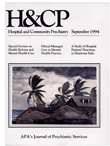Treated Prevalence Rates of Severe Mental Illness Among HMO Members
Abstract
Objectives: The authors examined the extent to which health maintenance organizations (HMOs) enroll and provide services to people with severe mental illness. Methods: The automatedpharmacy system of a large HMO identified members who bad received a peescription for an antipsychotic drug or lithium during the two-year study period (1986 and 1987). These data, combined with data from a 2 percent random sample of HMO members and from medical records, were used to identify members who satisfied DSM-iii-R criteria for schizophrenia and bipolar disorder. Treated prevalence rates derived from these data were compared with estimated treated prevalence data obtained in the National institute of Mental Health's Epidemiologic Catchment Area (ECA) survey. Results: Although methodological complications and small sample sizes precluded a detailed comparison, the study found a significantly lower treated preyalence rate of scbizophrenia among HMO members than in the ECA survey. The treated prevalence rate of bipolar disorder was also lower than the ECA rate, but the difference was not significant. Conclusions: The differences in treated prevalence rates seemed to be the result of different study methodologies and factors influencing HMO membership. The results underscore the need for a comprehensive study of the course of severe mental illness among HMO members.
Access content
To read the fulltext, please use one of the options below to sign in or purchase access.- Personal login
- Institutional Login
- Sign in via OpenAthens
- Register for access
-
Please login/register if you wish to pair your device and check access availability.
Not a subscriber?
PsychiatryOnline subscription options offer access to the DSM-5 library, books, journals, CME, and patient resources. This all-in-one virtual library provides psychiatrists and mental health professionals with key resources for diagnosis, treatment, research, and professional development.
Need more help? PsychiatryOnline Customer Service may be reached by emailing [email protected] or by calling 800-368-5777 (in the U.S.) or 703-907-7322 (outside the U.S.).



